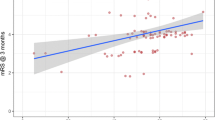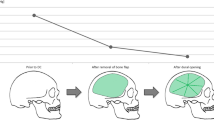The course of massive ischemic stroke (MIS) was studied in 105 patients. The results of investigations and intensive treatment identified a group of patients in which the course of MIS was benign, with no development of dislocation syndrome, and a group with a malignant course, with development of hemisphere cerebral edema and further transtentorial impact. Risk factors for the development of the malignant form of MIS and lethal outcomes were identified: lateral dislocation of greater than 7 mm, volume of ischemia greater than 70% of the frontal and parietal lobes and more than 80% of the temporal lobe, and impairment to the level of consciousness to moderate coma and worse. These were used to form a group of patients who underwent decompression craniotomy on the side of the lesioned hemisphere. This decreased lethality more than twofold compared with patients treated conservatively.
Similar content being viewed by others
References
Ch. P. Vorlou, M. S. Dennis, et al., Stroke. A Practical Handbook for Patient Management: A Monograph [in Russian], Politekhnika, St. Petersburg (1998).
P. A. Barber, A. M. Demchuk, J. Zhang, et al., “Computed tomographic parameters predicting fatal outcome in large middle cerebral artery infarction,” Cerebrovasc. Dis., 16, 230–235(2003).
J. Berrouschot, M. Sterker, S. Bettin, et al., “Mortality of space-occupying (‘malignant’) middle cerebral artery infarction under conservative intensive care,” Intensive Care Med., 24, No. 6, 620–623 (1998).
R. Dittrich, S. P. Kloska, T. Fischer, et al., “Accuracy of perfusion-CT in predicting malignant middle cerebral artery brain infarction,” Neurology, 6, 896–902 (2008).
C. Dohmen, B. Bosche, R. Graf, et al., “Identification and clinical impact of impaired cerebrovascular autoregulation in patients with malignant middle cerebral artery infarction,” Stroke, 38, 56–61 (2007).
The European Stroke Organization (ESO) Executive Committee and the ESO Writing Committee, Guidelines for Management of Ischaemic Stroke and Transient Ischaemic Attack 2008, www.eso-stroke.org/pdf/ESO08_Guidelines_Original_English.pdf, p. 61.
W. Hacke, S. Schwab, M. Horn, et al., “‘Malignant’ middle cerebral artery territory infarction: clinical course and prognostic signs,” Arch. Neurol., 53, 309–315 (1996).
H.-P. Haring, E. Dilitz, A. Pallua, et al., “Attenuated corticomedullary contrast: an early cerebral computed tomography sign indicating malignant middle cerebral artery infarction. A case-control study,” Stroke, 30, 1076–1082 (1999).
J. Hofmeijer, L. J. Kappelle, A. Algra, et al., “Surgical decompression for space-occupying cerebral infarction (the Hemicraniectomy After Middle Cerebral Artery infarction with Life-threatening Edema trial [HAMLET]: A multicentre, open, randomised trial,” Lancet Neurology, 8, 326–333 (2009).
E. Jüttler, S. Schwab, P. Schmiedek, et al., “Decompressive Surgery for the Treatment of Malignant Infarction of the Middle Cerebral Artery (DESTINY). A randomized, controlled trial,” Stroke, 38, 2518 (2007).
S. E. Kasner, A. Demchuk, J. Berrouschot, et al., “Predictors of fatal brain edema in massive hemispheric ischemic stroke,” Stroke, 32, 2117–2123 (2001).
W. Lam, T. Leung,W. Chu, et al., “Early computed tomography features in extensive middle cerebral artery territory infarct: prediction of survival,” Neurol. Neurosurg. Psychiatry, 76, 354–357 (2005).
P. Mitchell, B. A. Gregson, J. Crossman, et al., “Reassessment of the HAMLET study,” Lancet Neurology, 8, 602–603 (2009).
M. A. Moro, R. Leira, I. Lizasoain, et al., “The prediction of malignant cerebral infarction by molecular brain barrier disruption markers,” Stroke, 36, 1921–1926 (2005).
C. Oppenheim,Y. Samson, R. Manai, et al., “Prediction of malignant middle cerebral artery infarction by diffusion-weighted imaging,” Stroke, 31, 2175–2181 (2000).
S. Subramaniam, D. Michael, and M. Hill, “Decompressive hemicraniectomy for malignant middle cerebral artery infarction,” The Neurologist, 15, 178–184 (2009).
K. Vahedi, J. Hofmeijer, E. Juettler, et al., DECIMAL, DESTINY, and HAMLET investigators, “Early decompressive surgery in malignant infarction of the middle cerebral artery: a pooled analysis of three randomised controlled trials,” Lancet Neurol., 6, No. 3, 215–222 (2007).
Author information
Authors and Affiliations
Corresponding author
Additional information
Translated from Zhurnal Nevrologii i Psikhiatrii imeni S. S. Korsakova, Vol. 113, No. 1, Iss. I, pp. 15–22, January, 2013.
Rights and permissions
About this article
Cite this article
Krylov, V.V., Nikitin, A.S., Burov, S.A. et al. Decompression Craniotomy in the Complex Intensive Therapy of Malignant Forms of Massive Ischemic Stroke. Neurosci Behav Physi 44, 323–330 (2014). https://doi.org/10.1007/s11055-014-9913-6
Published:
Issue Date:
DOI: https://doi.org/10.1007/s11055-014-9913-6




